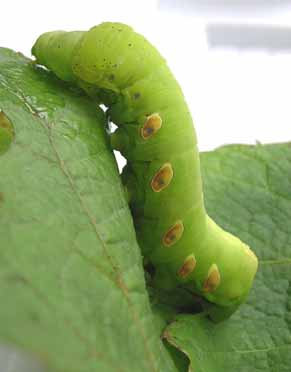
Sphinx or hawk moths, Family Sphingidae
This is taken primarily from an
extension bulletin by D. G. Pfeiffer & P. B. Schultz, entitled
"Major Insect and
Mite Pests of Grape in Virginia" (Va. Coop. Ext. Serv. 444-567 (1986))
Several species of sphinx moths feed on grape.
Three of the more common
are the Virginiacreeper sphinx, Darapsa myron (Cramer), the
achemon sphinx,
Eumorpha achemon (Drury) and the whitelined sphinx, Hyles
lineata
(Fabricius). Achemon sphinx pupae overwinter in the soil and adults
emerge in early May. Eggs are laid on foliage and hatch in six to
nine days. Larvae are hornworms, and a horn-like "tail" protrudes
upward from the end of the abdomen (this horn drops off older larvae).
Larvae feed on leaves for about 25 days, then go to the soil to
pupate. The above image, a larva of the pandorus sphinx, Eumorpha pandorus (photo credit
Anton Baudoin), was collected from grape foliage, and was found to be
parasitized by a braconid wasp.
Second generation moths appear in early July. The second generation
larvae are more numerous than in the first generation and do their
greatest damage in August. The life cycle of the other species of
sphinx moths is similar, although the number of generations may vary.
Back to Virginia
Vineyard
page
Back to Virginia Fruit Page
